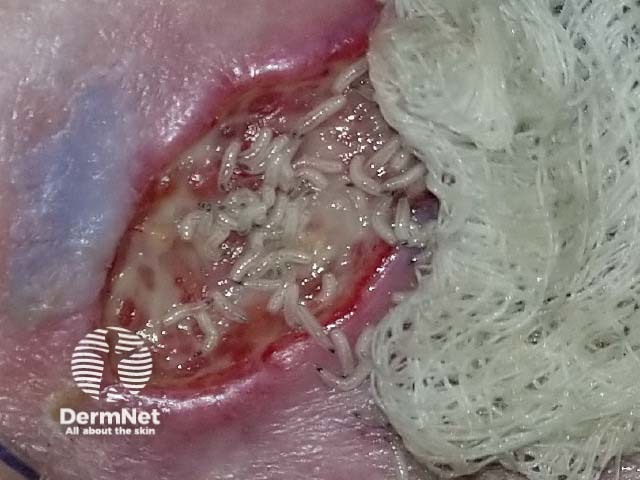Main menu
Common skin conditions

NEWS
Join DermNet PRO
Read more
Quick links
Maggots are fly larvae, just as caterpillars are butterfly or moth larvae. Their healing properties were first noted in the 16th century but their use in medicine in the western world only becoming popular after World War I when an American doctor noticed that soldiers with maggot infestation in wounds recovered better than soldiers without maggots in their wounds. Treatment of wounds with maggots was widespread throughout the 1930s but declined in the 1940s with the advent of antibiotics and surgical techniques.
Renewed interest in the use of maggots in medicine has been fuelled by the International Biotherapy Society, founded in 1996, who meet regularly to share experiences around the use of maggots in medicine. More recently, the BioTherapeutics, Education and Research (BTER) Foundation was established in early 2003 for the purpose of supporting patient care, education, and research into maggot therapy and other forms of symbiotic medicine.

Maggot therapy of chronic leg ulcer
The infestation of maggots in humans is known as myiasis. Myiasis can be beneficial or harmful depending on the type of maggot and the circumstances surrounding the infestation. In medical situations, “beneficial” myiasis is also known as maggot debridement therapy (MDT).
The wound healing properties of maggots is due to the following three actions:
The maggots are mixed into a wound dressing and the area is covered with gauze. After two or three days the dressing is cut away and the gorged maggots now up to 10 times their original 1 mm size are flushed from the wound.
The use of MDT is growing throughout the world; in the US there are approximately 300 centres, and about 1000 centres in the UK and Europe doing maggot therapy. One of the major limiting factors to MDT is reported to be “the willingness to try this technique”, by both doctor and patient.
The FDA approved clinical indication for MDT is “debridement of non-healing necrotic skin and soft tissue wounds such as pressure ulcers, neuropathic foot ulcers, chronic leg ulcers, or non-healing traumatic or post-operative wounds”.
Maggots for medicinal use must be surgical grade fly larvae that are bred from sterilized eggs in a laboratory. Not all maggots can be used, as there are some maggots that not only eat dead tissue but feed on living healthy tissue as well. Maggots also carry bacteria that may cause other infections so it is important that medical grade sterilized maggots are used.
There are several commercial companies around the world that produce medical grade maggots for MDT. One such medical grade maggot is LarvE“ produced by the Biosurgical Research Unit (Britain's sole maggot breeder) and is now available on prescription in the UK so that GPs can use MDT in the community. In the US, the FDA has approved the use of Medical Maggots‘ as a medicinal device.
MDT may cause pain or discomfort, particularly in patients already experiencing wound pain. This usually occurs about 24-36 hours into therapy, and worsens, as the larvae grow larger. Painkillers should help to relieve the pain; otherwise removing the maggot dressing provides immediate relief.
The maggots should be contained within the wound. If they escape onto unprotected skin around the edges of a wound, the larvae secretions can cause a rash on the skin that resembles a superficial burn.
MDT should only be used to treat wounds that are directly exposed to the outside. Once the maggots have completed their job they should be flushed out of the wound and disposed of as a bio-hazardous waste. Wounds should never be allowed to close over the maggots.
These articles are no longer accessible online (October 2009).